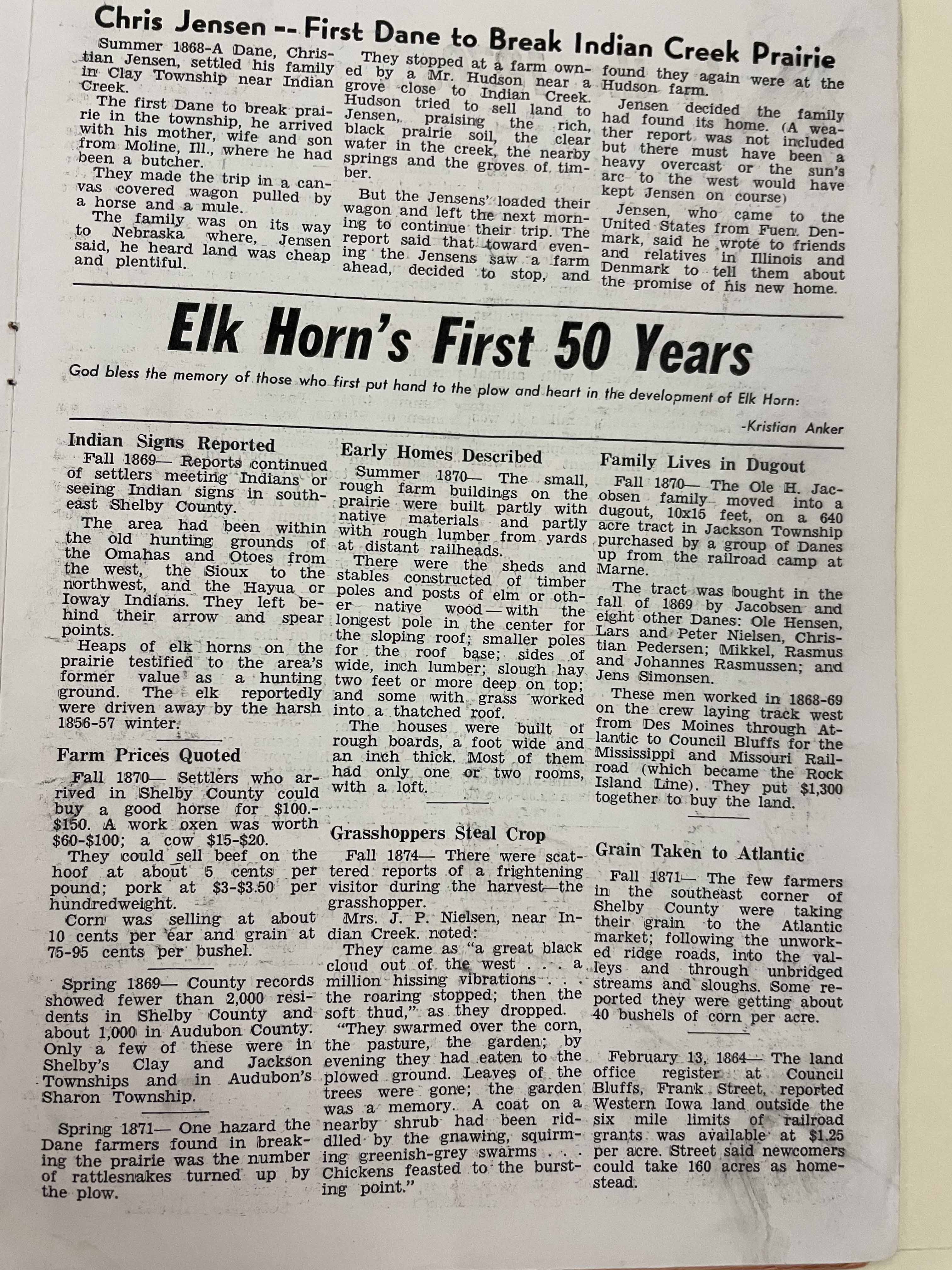Indian Signs Reported
Fall 1869-- Reports continued of settlers meeting Indians or seeing Indian signs in southeast Shelby County.
The area had been within the old hunting grounds of the Omahas and Otoes from the west, the Sioux to the northwest, and the Hayua or Ioway Indians. They left behind their arrow and spear points.
Heaps of elk horns on the prairie testified to the area's former value as a hunting ground. The elk reportedly were driven away by the harsh 1856-57 winter.
Farm Prices Quoted
Fall 1870-- Settlers who arrived in Shelby County could buy a good horse for $100-$150. A work oxen was worth $60-$100; a cow $15-20.
They could sell beef on the hoof at about 5 cents per pound; pork at $3-$3.50 per hundredweight.
Corn was selling at about 10 cents per bushel.
Spring 1869-- County records showed fewer than 2,000 residents in Shelby County and about 1,000 in Audubon County. Only a few of these were in Shelby's Clay and Jackson Townships and in Audubon's Sharon Township.
Spring 1871-- One hazard the Dane farmers found in breaking the prairie was the number of rattlesnakes turned up by the plow.
Early Homes Described
Sumer 1870-- The small, rough farm buildings on the prairie were built partly with native materials and partly with rough lumber from yards at distant railheads.
There were the sheds and stables constructed of timber poles and posts of elm or other native wood -- with the longest pole in the center for the sloping roof; smaller poles for the roof base; sides of wide, inch lumber; slough hay two feet or more deep on top; and some with grass worked into a thatched roof.
The houses were built of rough boards, a foot wide and an inch thick. Most of them had only one or two rooms with a loft.
Grasshoppers Steal Crop
Fall 1874-- There were scattered reports of a frightening visitor during the harvest--the grasshopper.
Mrs. J. P. Nielsen, near Indian Creek, noted:
They came as "a great black cloud out of the west . . . a million hissing vibrations . . . the roaring stopped; then the soft thud," as they dropped.
"They swarmed over the corn, the pasture, the garden; by evening they had eaten to the plowed ground. Leaves of the trees were gone; the garden was a memory. A coat on a nearby shrub had been riddled by the gnawing, squirming greenish-grey swarms . . . Chickens feasted to the bursting point."
Family Lives in Dugout
Fall 1870--The Ole H. Jacobsen family moved into a dugout, 10x15 feet, on a 640 acre tract in Jackson Township purchased by a group of Danes up from the railroad camp at Marne.
The tract was bought in the fall of 1869 by Jacobsen and eight other Danes: Ole Hensen [* Hansen], Lars and Peter Nielsen, Christian Pedersen; Mikkel, Rasmus and Johannes Rasmussen; and Jens Simonsen.
These men worked in 1868-69 on the crew laying track west from Des Moines through Atlantic to Council Bluffs for the Mississippi and Missouri Railroad (which became the Rock Island Line). They put $1,300 together to buy the land.
Grain Taken to Atlantic
Fall 1871-- The few farmers in the southeast corner of Shelby County were taking their grain to the Atlantic market; following the unworked ridge roads, into the valleys and through unbridged streams and sloughs. Some reported they were getting about 40 bushels of corn per acre.
February 13, 1864-- The land office register at Council Bluffs, Frank Street, reported Western Iowa land outside the six mile limits of railroad grants was available at $1.25 per acre. Street said newcomers could take 160 acres as homestead.
 Previous
Previous < == > Next
Transcribed by Cheryl Siebrass, July, 2022, from Elk Horn 1868-1918, page 3.
| 
